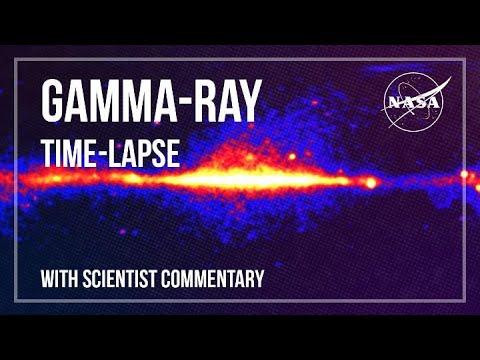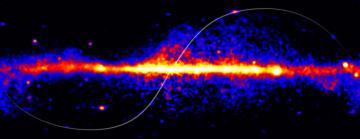Fermi mission creates 14-year time-lapse of the gamma-ray sky
Supermassive black holes at the hearts of distant galaxies – and even our own sun – shine in the new movie.
The cosmos comes alive in an all-sky time-lapse movie made from 14 years of data acquired by NASA’s Fermi Gamma-ray Space Telescope. Our Sun, occasionally flaring into prominence, serenely traces a path through the sky against the backdrop of high-energy sources within our galaxy and beyond.
"The bright, steady gamma-ray glow of the Milky Way is punctuated by intense, days-long flares of near-light-speed jets powered by supermassive black holes in the cores of distant galaxies," said Seth Digel, a senior staff scientist at SLAC National Accelerator Laboratory in Menlo Park, California, who created the images. "These dramatic eruptions, which can appear anywhere in the sky, occurred millions to billions of years ago, and their light is just reaching Fermi as we watch."

Narrated Tour of Fermi's 14-Year Gamma-Ray Time-Lapse
Gamma rays are the highest-energy form of light. The movie shows the intensity of gamma rays with energies above 200 million electron volts detected by Fermi’s Large Area Telescope (LAT) between August 2008 and August 2022. For comparison, visible light has energies between 2 and 3 electron volts. Brighter colors mark the locations of more intense gamma-ray sources.
“One of the first things to strike your eye in the movie is a source that steadily arcs across the screen. That’s our Sun, whose apparent movement reflects Earth’s yearly orbital motion around it,” said Fermi Deputy Project Scientist Judy Racusin, who narrates a tour of the movie, at NASA’s Goddard Space Flight Center in Greenbelt, Maryland.
Most of the time, the LAT detects the Sun faintly thanks to accelerated particles called cosmic rays – atomic nuclei traveling close to the speed of light. When they strike the Sun’s gas or even the light it emits, gamma rays result. At times, though, the Sun suddenly brightens thanks to powerful eruptions called solar flares, which can briefly make our star one of the sky’s brightest gamma-ray sources.
The movie shows the sky in two different views. The rectangular view shows the entire sky with the center of our galaxy in the middle. This highlights the central plane of the Milky Way, which glows in gamma rays produced from cosmic rays striking interstellar gas and starlight. It’s also flecked with many other sources, including neutron stars and supernova remnants. Above and below this central band, we’re looking out of our galaxy and into the wider universe, peppered with bright, rapidly changing sources.
Most of these are actually distant galaxies, and they’re better seen in a different view centered on our galaxy’s north and south poles. Each of these galaxies, called blazars, hosts a central black hole with a mass of a million or more Suns.
Somehow, the black holes produce extremely fast-moving jets of matter, and with blazars we’re looking almost directly down one of these jets, a view that enhances their brightness and variability. “The variations tell us that something about these jets has changed,” Racusin said. “We routinely watch these sources and alert other telescopes, in space and on the ground, when something interesting is going on. We have to be quick to catch these flares before they fade away, and the more observations we can collect, the better we’ll be able to understand these events.”
Fermi plays a key role in the growing network of missions working together to capture these changes in the universe as they unfold.
Many of these galaxies are extremely far away. For example, the light from a blazar known as 4C +21.35 has been traveling for 4.6 billion years, which means that a flare up we see today actually occurred as our Sun and solar system were beginning to form. Other bright blazars are more than twice as distant, and together provide striking snapshots of black hole activity throughout cosmic time.
Not seen in the time-lapse are many short-duration events that Fermi studies, such as gamma-ray bursts, the most powerful cosmic explosions. This is a result of processing data across several days to sharpen the images.
The concept for the LAT was invented at SLAC, the instrument was assembled and tested at SLAC, which was also responsible for the electronics and flight software, and SLAC continues to process newly downlinked data several times per day.
The Fermi Gamma-ray Space Telescope is an astrophysics and particle physics partnership managed by Goddard. Fermi was developed in collaboration with the U.S. Department of Energy, with important contributions from academic institutions and partners in France, Germany, Italy, Japan, Sweden, and the United States.
This story is based on an article from NASA.
Contact
For questions or comments, contact the SLAC Office of Communications at communications@slac.stanford.edu.
About SLAC
SLAC National Accelerator Laboratory explores how the universe works at the biggest, smallest and fastest scales and invents powerful tools used by researchers around the globe. As world leaders in ultrafast science and bold explorers of the physics of the universe, we forge new ground in understanding our origins and building a healthier and more sustainable future. Our discovery and innovation help develop new materials and chemical processes and open unprecedented views of the cosmos and life’s most delicate machinery. Building on more than 60 years of visionary research, we help shape the future by advancing areas such as quantum technology, scientific computing and the development of next-generation accelerators.
SLAC is operated by Stanford University for the U.S. Department of Energy’s Office of Science. The Office of Science is the single largest supporter of basic research in the physical sciences in the United States and is working to address some of the most pressing challenges of our time.






